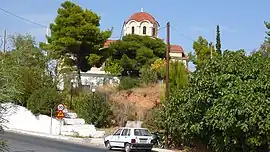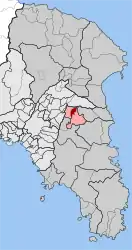Anthousa, Attica
Anthousa (Greek: Ανθούσα meaning "in blossom") is a suburban town in Athens East Attica regional unit, Greece. Since the 2011 local government reform it is part of the municipality Pallini, of which it is a municipal unit.[2] The municipal unit has an area of 3.865 km2.[3]
Anthousa
Ανθούσα | |
|---|---|
 | |
 Anthousa Location within the regional unit  | |
| Coordinates: 38°2′N 23°52′E | |
| Country | Greece |
| Administrative region | Attica |
| Regional unit | East Attica |
| Municipality | Pallini |
| • Municipal unit | 3.865 km2 (1.492 sq mi) |
| Elevation | 338 m (1,109 ft) |
| Population (2011)[1] | |
| • Municipal unit | 2,132 |
| • Municipal unit density | 550/km2 (1,400/sq mi) |
| Time zone | UTC+2 (EET) |
| • Summer (DST) | UTC+3 (EEST) |
| Postal code | 153 xx |
| Area code(s) | 210 |
| Vehicle registration | Z |
| Website | - |
History
Herbivorous and carnivorous animals lived in the area until 2004. These include mastodons, marmots, rhinoceroses, pigs, deer, giraffes, antelopes and gazelles, as well as a rare species of giant tortoise and hawks, sabertooths and hyenas. The area was quite isolated and is a place of residence for farmers, breeders, workers in the area of the Triangle and in the fields of Agios Athanasios, small townspeople and vacationers. After the important projects carried out in the wider area, the wild fauna of Anthousa is disappearing. It is connected to the two urban centers through the widened Anthousas and Marathons avenues, the Metro and the Suburban Railway, the Attica Road and the Regional Ymittos. Since then, it has also attracted the residential interest of the middle and upper urban classes. Each settlement develops its own cultural club, such as "Atlantis", "Anoixi", "OSAM" etc. contributing to the regeneration and cultural prominence of each neighborhood. Today it is a refuge for Mediterranean bears, foxes, deer and other smaller members of the Mediterranean fauna.
In the 10th century AD the construction of numerous Christian churches begins on the slopes of Mount Penteli, which marks the identification of Penteli with Christianity. With the liberation of the Turkish yoke and the formation of the modern Greek nation, the Holy Monastery is still the main owner of the mountain, which is offered for the ascetic needs of the monks. At the time of the Turkish rule, large areas of Anthousa belonged to Lazus mega-landowners, while with the establishment of the Holy Monastery of Penteli, the entire area of "gerotsakuli" from Rafina to Vrilissia became its property. During the years of the German occupation, the inhabitants of Penteli offered shelter to the Athenian rebels and suffered reprisals from the Germans, with the most typical being the arrest of the men of the village of Dau and their execution on the day of Agia Marina on the Lefidis hill in Pallini as a reprisal for the execution of the German Guard in Rafina. On the slopes of the mountain there are rebels, Sarakatsana shepherds, who feed on their produce and offer a piece of bread to the Athenians during the famine period.
The name of the area derives from the intense religious element common to the former ascetic slopes of Mount Penteli since the time of the foundation of the Holy Monastery of Penteli. It comes from the central Church of the community which has been honored in the name of Panagia (Holy Church of the Dormition of the Virgin). Literally, the name "Anthousa" corresponds to the one that flourishes, that is, it is in a state of growth and euphoria. The Atlantidos community park can be seen on the community emblem.
Geography
Anthousa is situated in the eastern part of the Athens conurbation, at about 300 m elevation. It lies in the southern foothills of the Penteliko Mountain. It is 3 km north of Pallini, 2 km south of Penteli and 14 km northeast of Athens city centre. Motorway 6 passes southwest of Anthousa.
Historical population
| Year | Village population | Community population |
|---|---|---|
| 1981 | 577 | - |
| 1991 | 2,787 | 3,020 |
| 2001 | - | 3,024 |
| 2011 | - | 2,132 |
See also
References
- "Απογραφή Πληθυσμού - Κατοικιών 2011. ΜΟΝΙΜΟΣ Πληθυσμός" (in Greek). Hellenic Statistical Authority.
- "ΦΕΚ B 1292/2010, Kallikratis reform municipalities" (in Greek). Government Gazette.
- "Population & housing census 2001 (incl. area and average elevation)" (PDF) (in Greek). National Statistical Service of Greece. Archived from the original (PDF) on 2015-09-21.